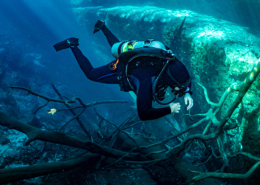What’s the Big Deal with Lionfish Being Invasive?
By Jordan Bridges
Many people know that Caribbean and Atlantic lionfish are invasive. Few, however, really understand why their presence is a big deal.
Lionfish are naturally part of the Indo-Pacific and Middle East ecosystems. Their natural role in these parts of the world is to be what is called a secondary consumer.
https://cdn.britannica.com/99/95199-004-D2AE1838.jpg
If you look at the picture of a basic food chain, lionfish are supposed to be where the Ocean Sunfish is. However, over the past 20 years, lionfish have stolen a spot on the top of the chain. This is where sharks are in the Atlantic Ocean without the natural population controls. This has led them to break the natural ecosystem of the Atlantic Ocean and Caribbean Sea.
Why this is a problem
If you think about a typical top oceanic predator, you probably think of a large shark or a killer whale. Again, we can use the diagram of an ocean food web for a guide. If you’re at the top of the food chain, how is your population controlled if no one is hunting you down?
- The first is reproduction rate. Large sharks such as the Sand Tiger (Carcharius Taurus) have only two pups at a time. This happens every two to three years. It means they reproduce by about one pup per year.
- The second thing that controls the population of top predators is how long it takes to become sexually mature. A new Sand Tiger pup won’t be able to reproduce until they are about ten years old.
These two things help keep the populations of natural members at the top of food chains under control.
We can also use ourselves as an example of a top predator. If we remove all our fancy technology and medicine, and return to our natural way of life, we are no better off than sharks. Most women only have one baby at a time and can do so only every two years or so. Humans also aren’t sexually mature until about 12 (even though culturally, we wait even longer). Without those types of controls on our population our numbers can grow untamed (with all our modern medicine and technology, some argue that we are becoming that way now).
In contrast, lionfish can lay up to one million eggs per year. They become sexually mature in only 2 years of life. In the Indian Ocean and Pacific, lionfish are naturally a middle-predator. This means normally they would have predators acting as population control.
In the Caribbean and Atlantic, where they have invaded, lionfish have no natural predators. This has allowed the lionfish population to grow without limits. This means lionfish have forced their way to the top of the food chain. This untamed population has led to what we know to be the problem: Degradation of the Caribbean and Atlantic coral reef ecosystems.
Lionfish are not picky eaters. They will eat anything. Mostly, they eat the grazers. These are the fish and shrimp that eat algae. This results in algae growing on top of all the pretty corals. Turning colorful reef landscapes into murky green wastelands.
https://scripps.ucsd.edu/news/pristine-degraded-reefs-central-pacific
Look at the before-and-after photos of the same reef. Lionfish aren’t solely responsible for the decline, but they do play a big part in it.
Fighting the invader
Current efforts to control the lionfish invasion are led by sport divers, like us using pole spears. Most of the affected coastlines don’t have fishing license requirements for lionfish. This means sport divers can kill them without any restrictions. Lionfish tournaments can wipe out thousands of lionfish in a single weekend.
Scuba diver with a loaded pole spear aimed at a lionfish. Photo by Shawn Harper of the North Carolina Aquarium on Roanoke Island.
Beyond scuba diving, lionfish are common bycatch for many lobster fishermen. This is because lionfish and lobsters prefer similar habitats.
There is also a lot of research being done by NOAA and other academic institutions to find new insights into lionfish ecology. There are innovations such as traps and Remotely Operated Vehicles (ROVs) being developed to make lionfish hunting more efficient.
So, what else can we do to make a dent in this invasion? EAT THEM!
- If you’re diving in the Atlantic, go ahead a take a spear with you. Kill any lionfish you find. If they are big enough, eat them.
- When you make a good haul, have a barbecue and share your catch with neighbors.
Lionfish are delicious, and safe to eat because the flesh is not venomous. If we can get more people to develop a taste for lionfish, we can get them on coastal menus.
We have seen what happens when humans develop a taste for tuna, groupers and the like. When humans like to eat something, we can eat them into endangerment. Now we have something we can eat guilt-free. Lionfish ceviche is one of the favorite lionfish dishes.
https://pcjcookshop.files.wordpress.com/2012/12/p1050192.jpg
As divers, we love the ocean. For most of us, that was our motivation for becoming divers in the first place. It is fitting for us to advocate taking care of the ocean we love to explore.
Many divers who have traveled to the eastern United States have heard that, “Lionfish are invasive and destroying the reef.” What they may not understand is exactly how lionfish degrade the reefs and how they became so successful. This can lead less-informed divers to think, “So what? There’s a new species. Who cares?” It falls to the rest of us to educate the uninformed.
I hope this gives you a better glimpse at how lionfish are so successful and how they are degrading reefs.














Tinggalkan balasan
Ingin bergabung dalam diskusi?Silahkan berkontribusi!